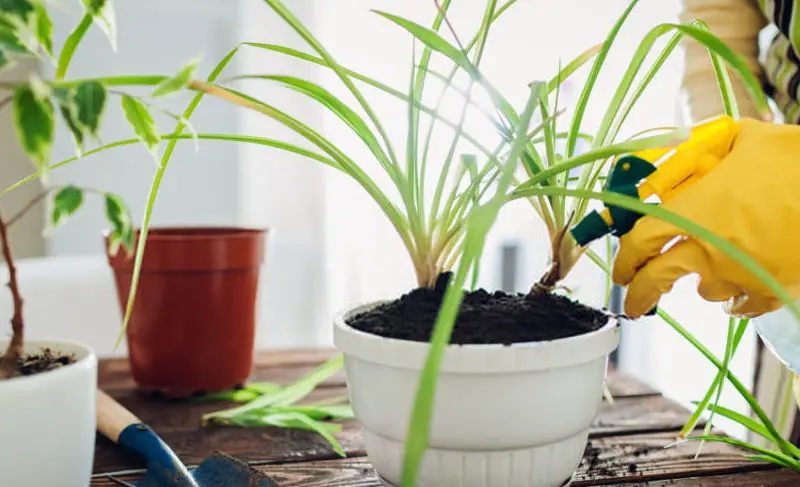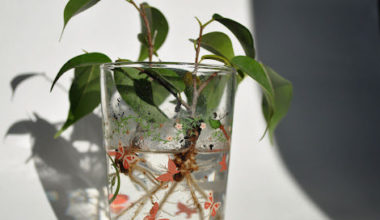Also known as phalanx or hairy chlorophytum, the spider plant is an herbaceous plant that thrives mostly indoors and in pots.
Appreciating indirect sunlight, this robust perennial, native to South Africa, is very easy to maintain. Ideally installed in suspension, it dresses up your interiors with its variegated green-cream color.
The spider plant reproduces easily. And we owe it to its constitution. Its stems, or stolons, give life to buds, which gives birth to a group of leaves which take root. This gives free rein to reproduction through vegetative propagation. The plant also reproduces sexually.
Contents
How does the spider plant reproduce?
The spider plant multiplies spontaneously: it produces long stolons on which small seedlings develop which take root if they meet a suitable substrate (then count 5 to 6 weeks to be able to separate the seedling from the mother plant).
One can also proceed by division of the clump, not of panic, one explains you how to make just below.
3 methods of reproduction in the spider plant
The spider plant reproduces very easily by layering thanks to its stolons which form new plantlets or rosettes, furnished with leaves and roots. It is a method which works well, but which requires space.
It is also multiplied by division of clump or by cuttings.
1. Aerial layering
The spider plant is a plant which makes many rejections. It is possible to use these seedlings to multiply the plant.
You can intervene at the time of the year that suits you:
- Push the new rosettes into pots filled with sandy soil preferably, all around the mother plant.
- Be careful not to detach the rosettes from the mother plant.
- For safety, secure them with a wire.
- To obtain a larger clump, you can put 3 rosettes together in the same pot.
- After about 6 weeks, check that they have taken root and separate them from the mother plant by cutting the stems.
- Then cultivate as adult plants.
2. Cutting
If they already have roots, then simply detach them and repot them in potting soil. If not, the cuttings can be placed in potting soil or a glass of water until the roots form.
- Remove the seedlings that have formed on the runners. You can let them take root in a glass of water or plant them immediately in potting soil. Be sure to pick seedlings with leaves of at least 3 inches.
- If the seedlings have roots, place them in a jar filled with water and wait until the roots reach 1 inch before repotting.
- If the seedlings do not have roots, dip them in powdered cuttings hormones and plant them in a moist mixture of peat and sand. After 6 weeks or more, once the roots have formed, repot them.
- Then cultivate as mature plants.
3. Clump division
You can divide the plant when repotting in spring:
- Gently remove the soil between the roots.
- Separate the clump in several pieces, cut the damaged roots.
- Replant only the youngest parts around the edge.
Why my spider plant won’t reproduce
If a spider plant doesn’t produce babies, it’s for another reason. And it’s usually either because it’s too young to do so (it usually has to be about a year old before it can produce seedlings) or it’s not getting the growing conditions it needs. And this is not very common.
As it happens, the spider plant is extremely easy to grow (indoors at least; to succeed outdoors, it requires a tropical climate). It can tolerate irregular watering, prolonged drought, little or no fertilizer and extreme temperatures and will still produce at least a few babies on its famous drooping runners.
But what it cannot tolerate is insufficient light.
Remember that light is the only source of energy for green (chlorophyllous) plants. Light is as important to them as food is to humans. The spider plant is incredibly tenacious and will survive for years in a low light situation, essentially half dead from lack of solar energy, but it will not flower under these conditions… and for this plant, flowering is the essential first step in producing babies.
How to take care of new spider plant cuttings?
The spider plant tolerates the shade and the half-shade in outside and the bright light in inside, without however direct sun. Avoid drafts for any plant grown indoors.
It likes light, well-drained, humus-rich soil.
Ideally, prefer a mixture of potting soil and garden soil. However, a few things can be essential to keep it healthy:
- The spider plant appreciates a bright exposure, but without direct sun, especially for variegated varieties. If you take your pots outside or if you grow it outside, place it in half-shade or even in the shade.
- A temperature of 65 °F is ideal, beyond that, you have to baste the foliage which tends to dry out. In winter, keep it at a temperature of 45 to 50 °F.
- Water regularly but moderately in summer, because its tuberous roots store water. It supports more easily a forgotten watering than a soaked substrate.
- It does not need much water in winter. Water more sparingly, letting the surface dry out a few centimeters between waterings.
- Do not let water stagnate in its saucer.
- Fertilize twice a month from early spring to early fall.
- Outdoor plants will withstand a temporary cold snap if their roots are protected by a mulch. The foliage will burn, but it will come back from the stump in spring.
- Aerate, or better yet, take your plant outside in summer.
- Re-pot as soon as the roots occupy the entire pot (they then emerge through the water drainage hole), and at least once a year.
- Remove the dead leaves and remove the damaged parts without cutting the healthy part.









